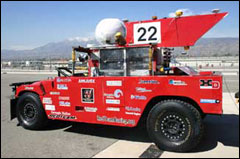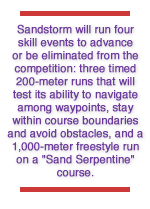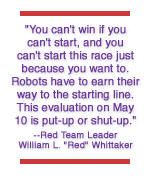|
|
|||||
|
|
Carnegie Mellon's Sandstorm Robot Will Run Time Trials To Prove It Can Compete in $2-Million Desert Race
Trials to be Webcast at 6 p.m. (EDT), May 10
Sandstorm, which went furthest and fastest in the first Grand Challenge, held in March 2004, will be tested by DARPA evaluators at the Nevada Automotive Test Center (www.natc-ht.com) near Carson City, Nev. Carnegie Mellon's Red Team, which built Sandstorm, is one of 118 teams hosting similar evaluations. The evaluation process will cut 78 of the competitors. Forty teams will advance to the semifinals in September. And ultimately 20 of these will race on Oct. 8.
No remote control is allowed in the Grand Challenge race, so machines must sense and drive autonomously by computing where and how to drive. Seven Intel Pentium-M's and a 64-bit Itanium-2 computer process terrain models, plan routes, avoid hazards and direct Sandstorm's driving. The robot maps terrain with seven laser range scanners, four stereo cameras and two radar sensors. Some of these are mounted on a gimbal, which operates like an animal's neck to stabilize and point the sensors. The gimbal is a collaborative development with HD Systems, Philips and KVH.
Sandstorm is built from a 1986 HUMMER. HD Systems actuators steer and brake the vehicle. TTTech controllers regulate the brakes, shift the transmission and shift the transfer case. Caterpillar electronics regulate the speed, while Applanix technology estimates Sandstorm's location by combining inertial, GPS and odometry data.
Carnegie Mellon's ambition is to put two machines on the Grand Challenge starting line and one in the winner's circle. Its H1ghlander robot, built by the university's Red Team Too, was evaluated in Pittsburgh on May 5.
"You can't win if you can't start, and you can't start this race just because you want to," said Whittaker. "Robots have to earn their way to the starting line. This evaluation on May 10 is put-up or shut-up."
Results of the site visits will be announced on June 1.
For more information on the Red Team and the Sandstorm robot, including logistical details about its evaluation, see www.redteamracing.org.
For more information on Red Team sponsorship, see www.redteamracing.org/sponsors.
For more information on the Grand Challenge, see www.darpa.mil/grandchallenge/GC05_site_visit%20_2_.pdf.
Anne Watzman |
|||
|
Carnegie Mellon Home |
|||||

 Sandstorm will run four skill events to advance or be eliminated from the competition. Race officials will evaluate its performance in three timed 200-meter runs that will test its ability to navigate among waypoints, stay within course boundaries and avoid randomly placed obstacles. The robot will maneuver itself through a 1,000-meter freestyle run on a "Sand Serpentine" course, steering through hairpin curves and following trails strewn with boulders.
Sandstorm will run four skill events to advance or be eliminated from the competition. Race officials will evaluate its performance in three timed 200-meter runs that will test its ability to navigate among waypoints, stay within course boundaries and avoid randomly placed obstacles. The robot will maneuver itself through a 1,000-meter freestyle run on a "Sand Serpentine" course, steering through hairpin curves and following trails strewn with boulders.
 The Red Team is sponsored by an alliance that includes Caterpillar, Boeing and AM General, among many others. According to Red Team leader William "Red" Whittaker, the Red Team is united to catalyze new technology, inspire the world and build leaders of tomorrow.
The Red Team is sponsored by an alliance that includes Caterpillar, Boeing and AM General, among many others. According to Red Team leader William "Red" Whittaker, the Red Team is united to catalyze new technology, inspire the world and build leaders of tomorrow.